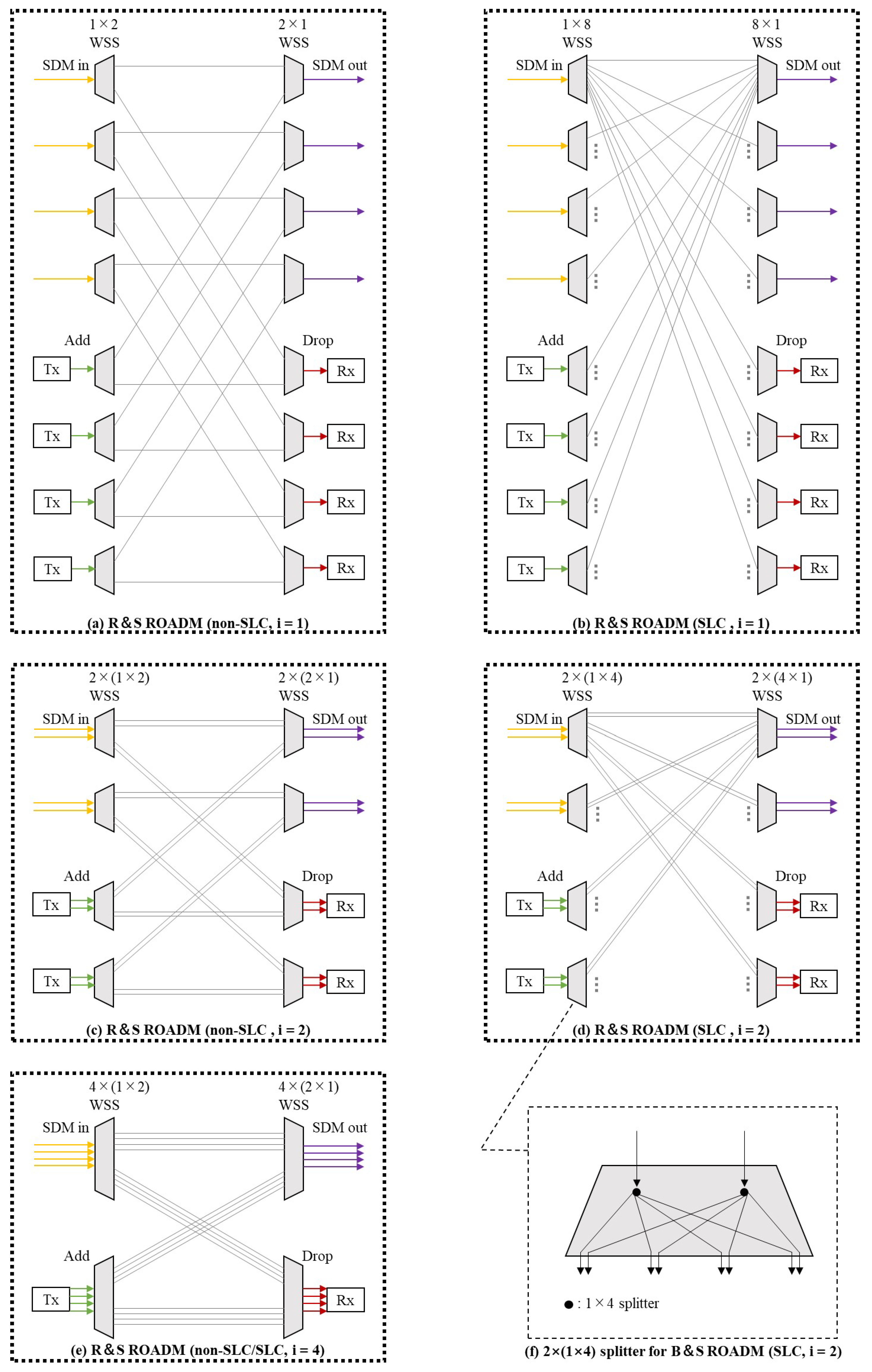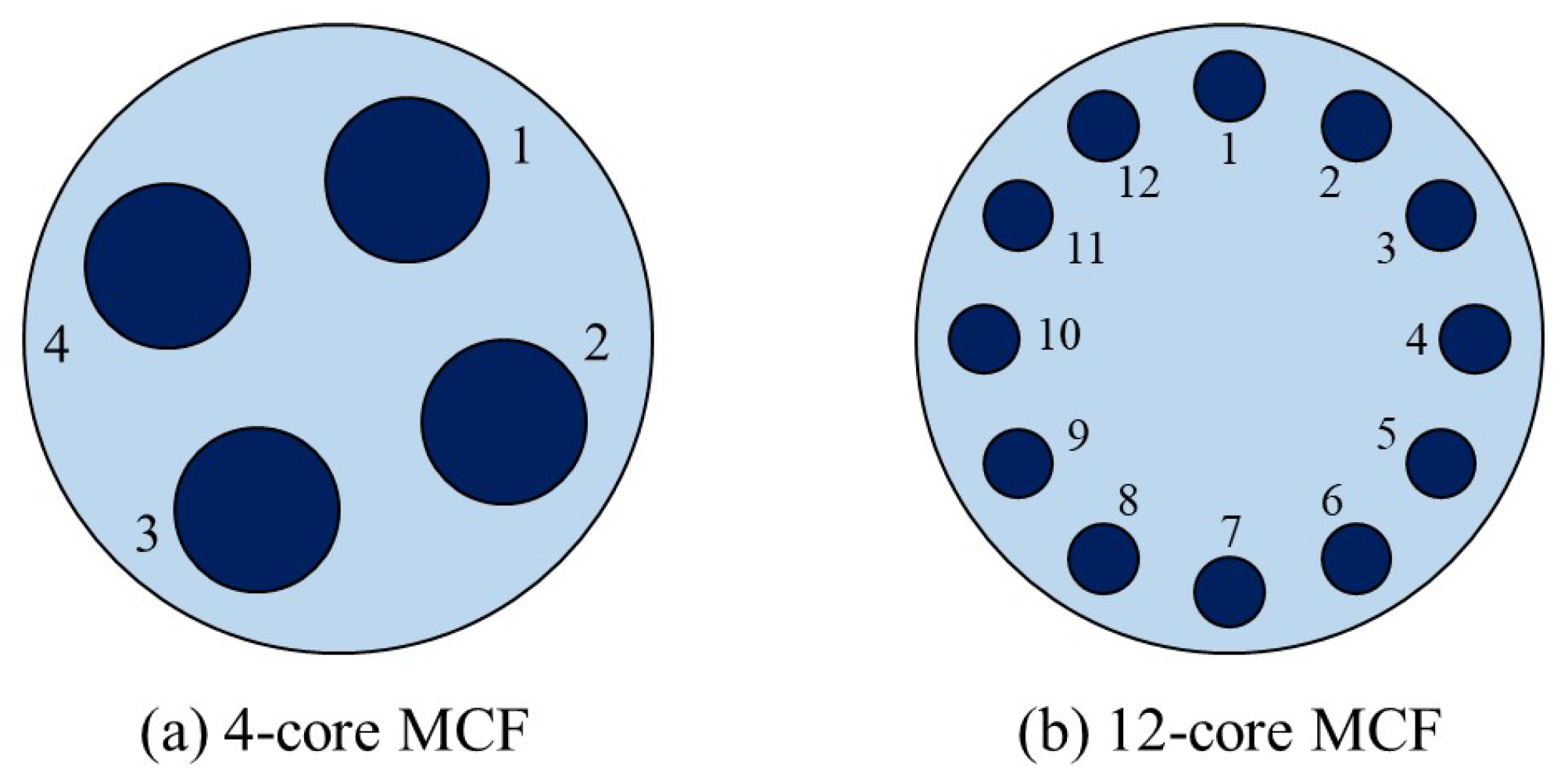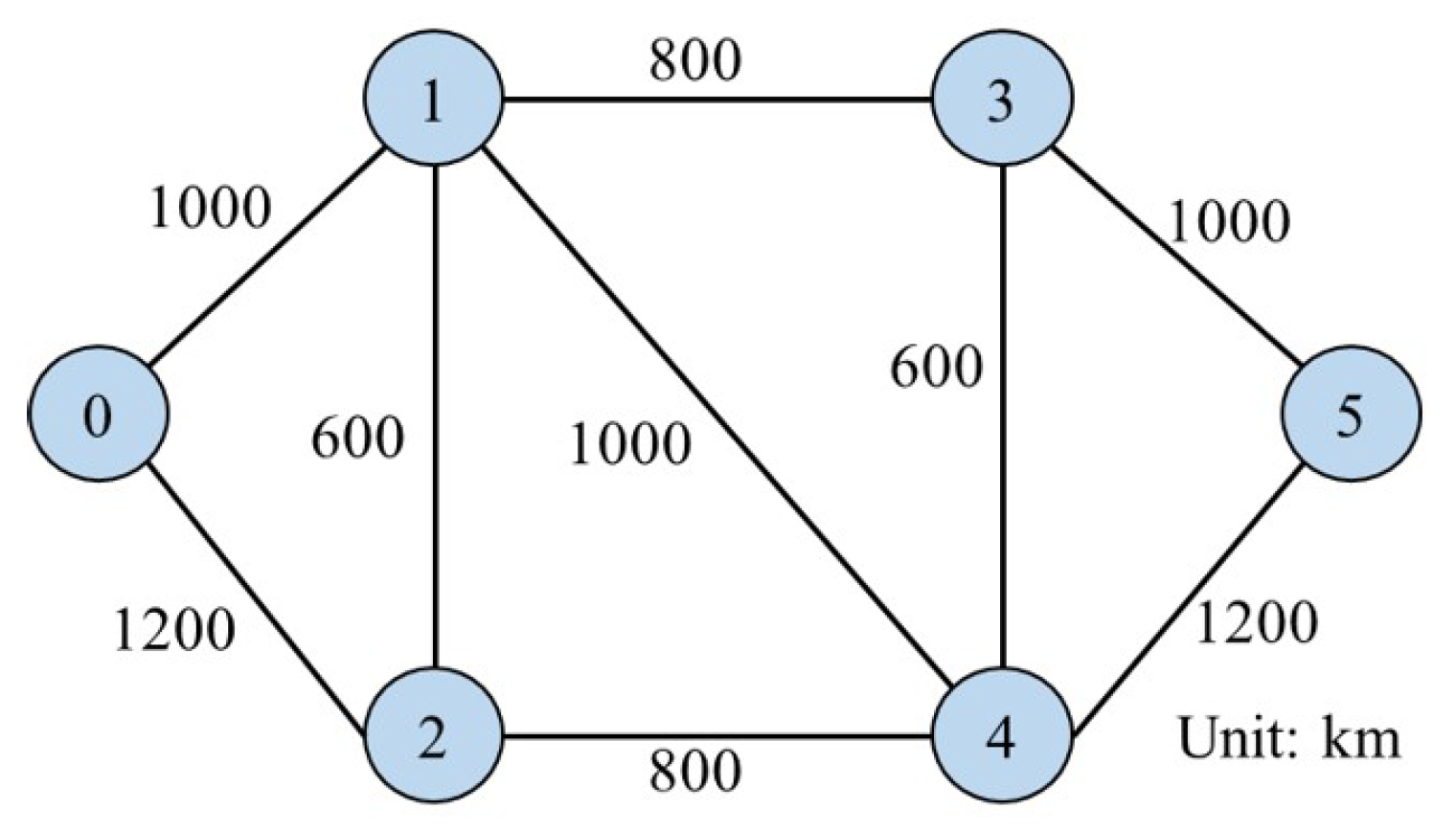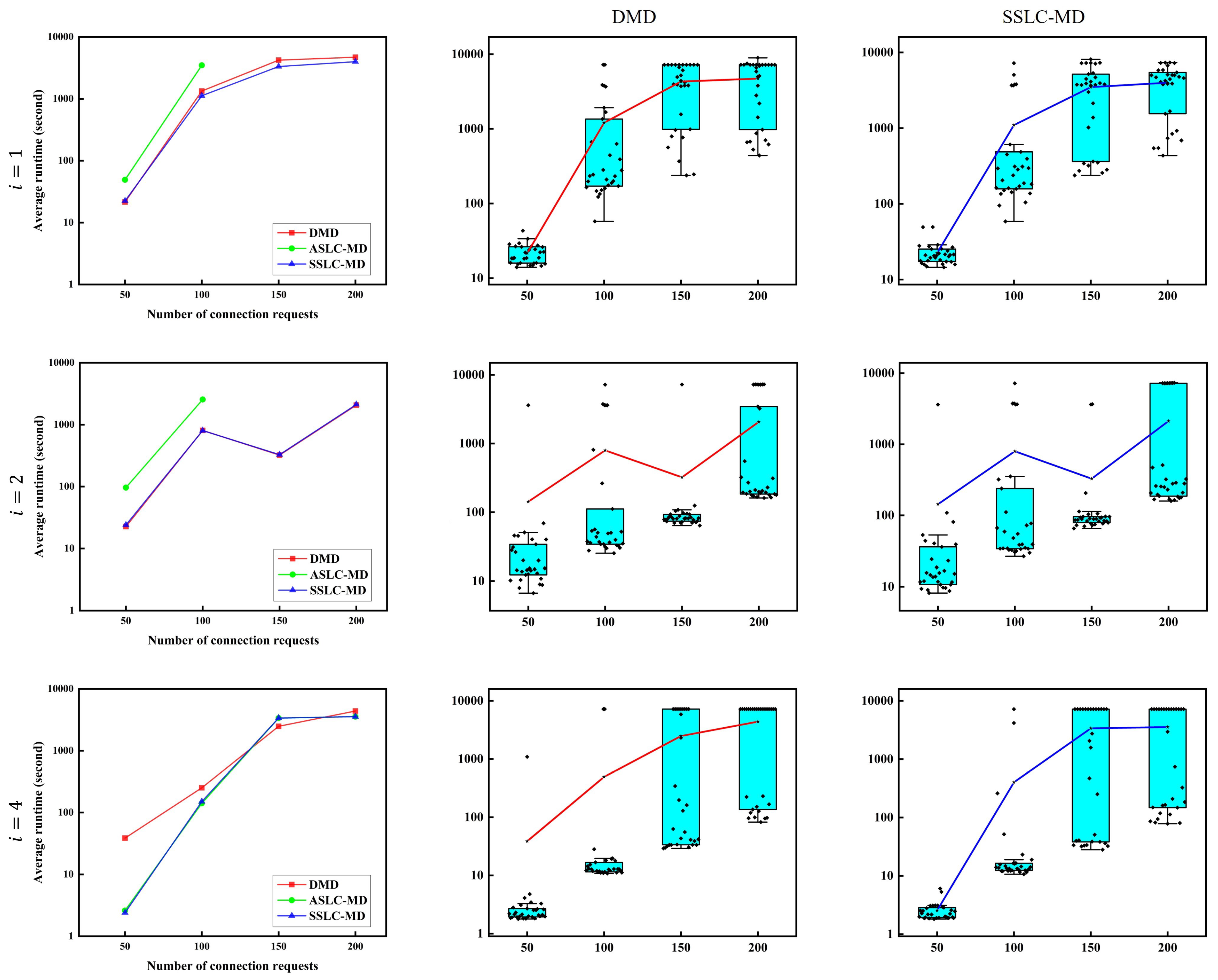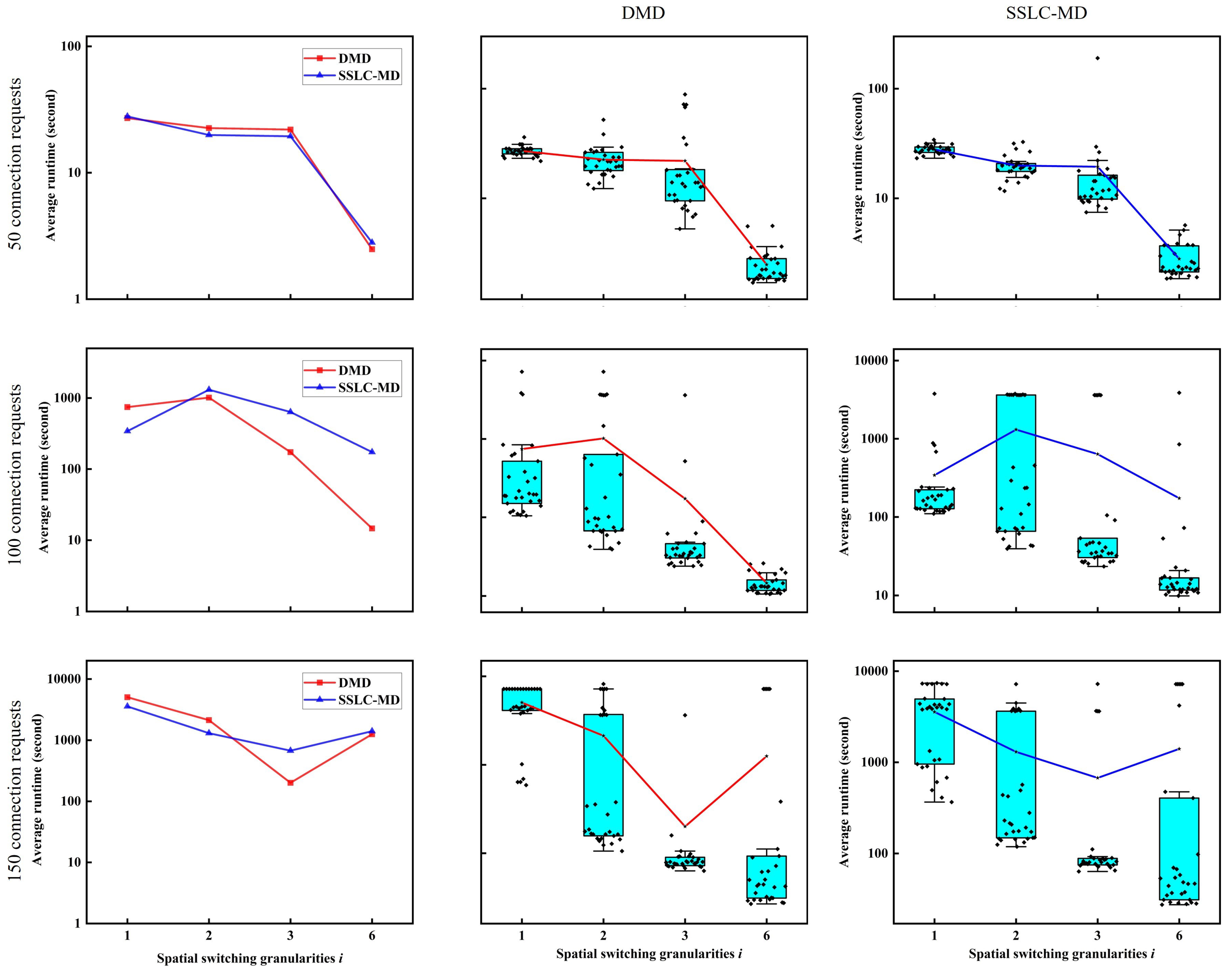4.1. Environmental Parameters and Assumptions
We perform the three algorithms above in a 6-node 18-directed link N6S9 network [
12]. In addition, we compare our model with the k-path-type model from the previous work [
11] in a 14-node 42-directed link NSF network [
36]. As shown in
Figure 6, we consider several cases, where each link uses the 4-core MCF [
37] or the 12-core MCF [
38] to connect the network in the simulation experiments.
Based on the ITU-T standard G.694.1, the total number of FSs that each link has (i.e.,
) is set to 320 (i.e., 12.5 GHz per FS at the C-band with a 4 THz bandwidth) [
39]. The number of modulation levels
is set to 4. The numbers 1, 2, 3, and 4 indicate the modulation formats double polarization (DP)-BPSK, DP-QPSK, DP-8QAM, and DP-16QAM, respectively. Each OC is generated by a transceiver, which can support 50 Gbps via DP-BPSK under the 32 Gbaud symbol rate containing 7 GBaud (approximately 20%) for forward error correction (FEC) overhead [
40] and occupying in total 37.5 GHz spectrum (i.e., 3 FSs) [
41]. Therefore, the supportable bit rates per OC for the modulation formats DP-BPSK, DP-QPSK, DP-8QAM and DP-16QAM are set to 50, 100, 150 and 200 Gbps, respectively.
For the maximum transmission distances (km) of the considered modulation formats above, we consider that they are mainly driven by two factors: a) the optical signal-to-noise ratio (OSNR), and b) the inter-core crosstalk (XT) of MCFs. As shown in
Table 4, these physical features of the two types of MCFs we mentioned above are used to calculate the maximum transmission distances for different modulation formats. The parameters
k,
,
and
represent the coupling coefficient, core pitch, propagation constant, and bend radius, respectively. It should be noted that the coupling coefficients
k are calculated according to Ref. [
42]. In the coherent systems, the maximum transmission distances of different modulation formats are bounded by OSNR, and can be estimated by the Gaussian Noise model of nonlinear interference [
43]. The XT of a connection request in MCFs after
D km can be calculated by Equation (
25).
In Equation (
25),
C represents the number of adjacent cores of the core transmitting the current connection request. We assume that the thresholds of XT (
) for modulation formats DP-BPSK, DP-QPSK, DP-8QAM, and DP-16QAM are −14, −18.5, −21, and −25 dB, respectively [
44], and that the XT oscillation requires a −2 dB margin (
) [
13]. Therefore, for a given modulation format
m, the maximum transmission distance bounded by XT (
) can be calculated by Equation (
26):
For connection requests in 4-core and 12-core MCFs with different modulation formats, we can calculate the maximum transmission distances bounded by OSNR (
) [
43] and XT (
), respectively, as shown in
Table 5. The maximum transmission distance is the small one of
and
.
Therefore, the maximum transmission distances (km) of these modulation formats considered and the maximum traffic volume (Gbps) that an OC can carry under each modulation format are shown in
Table 6.
The Gurobi optimizer v9.0.1 [
45] is the solver software used to solve the models in this paper. Since the RSA problem is a well-known NP-hard problem that has been proven by [
8,
9], it is obviously NP-hard for the RMSSA problem that considers multiple spatial dimensions and modulation formats based on the RSA problem. Thus, for some instances, ILP models cannot be completely solved in a reasonable time (i.e., the obtained solution cannot be verified as optimal). To obtain a feasible solution of the model when solving each instance, we set an upper limit of 3600 s for the computation time of each part of the algorithms (e.g., in the DMD algorithm, the upper limit of computation time for the RMSA, SA, and RMSSA models are all 3600 s). The simulation experiments are executed in a Microsoft Windows 10 OS on a computer with an Intel 8-core 16-thread 3.6 GHz CPU and 64 GB memory.
4.2. Simulation Results of the DMD, ASLC-MD and SSLC-MD Algorithms
In this subsection, we compare the algorithms for solving the non-SLC node-type model in the N6S9 network shown in
Figure 7, which consists of 6 nodes and 18 directed links interconnected by 4-core MCFs [
37]. The available spatial switching granularities
i are 1, 2, and 4, corresponding to the cases of Ind-Sw, FrJ-Sw, and J-Sw, respectively.
The traffic volume (Gbps) of each connection request is generated ranging from 100 Gbps to 1 Tbps in accordance with a uniform distribution. The source node and destination node of each connection request are randomly selected from the nodes in the network topology used. We consider different numbers of connection requests—from 50 to 200, 50 per step. Thirty traffic data sets are generated randomly for each number of connection requests.
Since there is not yet any work that involves multiple modulation formats by formulating node-type ILP models to solve the RMSSA problem, we consider lower bounds of the model and results of the following commonly used first-fit greedy (FF-G) algorithm [
14] for solving the model as the indicators to evaluate the effectiveness of our algorithms. Regarding the FF-G algorithm as shown in Algorithm 1,
is a set of different sorting methods. We discuss nine sorting methods according to the different properties of connection requests, which are sorting by traffic volume from small to large and large to small, the average hops of all paths from small to large and large to small, the hops of the shortest path from small to large and large to small, the hops of the longest path from small to large and large to small, and random sorting. We previously searched for all possible simple paths (i.e., paths without cycles) between the source and destination nodes of each connection request via the depth-first search (DFS) algorithm, and the set of all possible simple paths for the connection request
r is denoted as
.
| Algorithm 1 First-fit greedy. |
- 1:
Update the available FSs and spatial dimension groups - 2:
for in do - 3:
Sort the set of connection requests R via - 4:
for r in R do - 5:
Find all physical paths for r - 6:
for p in do - 7:
Determine the most efficient modulation format for each physical path p via DAT - 8:
end for - 9:
Calculate - 10:
Create the candidate spectral blocks set with spatial continuity and FSs contiguity restrictions imposed, and is composed of FSs - 11:
for in do - 12:
Assign to r on a trial and calculate the maximum index of the FSs used in the network after the trial assignment - 13:
end for - 14:
Find the minimum , realign its corresponding to r and update the available FSs and spatial dimension groups - 15:
end for - 16:
Record the maximum FSs index used in the network under the current sorting method of R - 17:
end for - 18:
Select the allocation scheme for the sorting method, which determines a minimum value of the maximum FSs index used in the network
|
Table 7 shows the experimental results for the maximum FS index of the non-SLC node-type model solved by the DMD, ASLC-MD, SSLC-MD and FF-G algorithms in the cases of spatial switching granularities
i equal to 1, 2, and 4. The result is the value of the parameter ‘ObjVal’ output by Gurobi, which is the global optimal value when the model is completely solved in the time limit and is the local optimal value or current best value if a solution exists when the model is not completely solved in the time limit. ‘LB’ indicates the lower bound given by the parameter ‘Objbound’ of Gurobi when solving the RMSA model. The numbers listed in the parentheses indicate the numbers of sets in the 30 traffic data sets for which the optimal solutions are not obtained within the time limit (i.e., the number of times the model is not solved completely). The ASLC-MD algorithm does not obtain feasible solutions in the time limit for instances whose numbers of connection requests are 150 and 200. For the 30 traffic data sets with 150 connection requests, there are 24 sets when
i is equal to 1 and 29 sets when
i is equal to 2, where no feasible solution is found. For the 30 data sets with 150 connection requests, no feasible solutions are found for all 30 sets when
i is equal to 1 and 2. As shown in
Table 7, the results of the ASLC-MD algorithm are not very satisfactory, and it would be difficult to find feasible solutions in a reasonable time when the number of connection requests becomes larger. By comparing the results of the DMD, SSLC-MD, FF-G algorithms and lower bound, it can be observed that DMD and SSLC-MD can effectively solve the node-type model in the instances that were originally difficult to solve directly, and the qualities of the solutions obtained by DMD and SSLC-MD in the time limit were approximately the same and much better than the solutions obtained by heuristic FF-G algorithm.
Furthermore, it can be observed that with the number of connection requests being 150 and 200, all of our three algorithms yielded a large number of instances that could not be solved completely within the time limit. As we analyzed in
Section 3.5, our model is strongly influenced by the number of connection requests. Therefore, when facing large-scale instances with a high number of connection requests, it will be difficult to solve in a reasonable time. In our pre-experiments, we noticed that the maximum number of connection requests that our algorithms can handle in the limited 10,000-second time is about 300. That is, for instances larger than 300 connection requests, we suggest using other efficient heuristic algorithms to solve them.
Figure 8 shows the experimental results regarding the execution time of the non-SLC node-type model solved by the DMD, ASLC-MD and SSLC-MD algorithms in the cases of spatial switching granularities
i equal to 1, 2, and 4. The vertical coordinate called ‘average runtime’ indicates the average execution times of Gurobi when solving the model. The horizontal coordinate indicates the number of connection requests from 50 to 200 with 50 requests per step. Since the computation time of the heuristic FF-G algorithm is more than 10 times faster than those of the DMD, ASLC-MD, and SSLC-MD algorithms, which are used to solve the model, we do not include it in the comparison. The three figures in the left-hand column show the average execution times of the three algorithms used to solve the model for various values of spatial switching granularities
i. The performance of the ASLC-MD algorithm was the worst. Moreover, by comparing the other two algorithms, DMD and SSLC-MD, it can be observed that in the case where the switching paradigms of the SLC and non-SLC models are different (i.e., the cases where
and
), there is a larger number of spatial dimension groups, and the performance of SSLC-MD is superior to that of DMD (e.g., the average execution time of SSLC-MD is shorter than that of DMD in the case of
; however, in the case of
, since the number of spatial dimension groups is reduced, the advantage of SSLC-MD compared to DMD is also reduced). In the case where
, the switching paradigms of SLC and non-SLC are the same, and the results of DMD and SSLC-MD are both good and bad. The figures in the middle column and the right-hand column show the box plots of the results of DMD and SSLC-MD for various cases of spatial switching granularities
i, respectively, and we can see the dispersion of the results for all 30 traffic data sets through these plots.
To better verify the difference in performance between the DMD and SSLC-MD algorithms with different numbers of spatial dimension groups, we increase the number of cores of MCF to 6 and perform experiments using the same 30 traffic data sets with connection request numbers of 50, 100, and 150. In this case, there are 4 possible values of spatial switching granularities, which are 1, 2, 3, and 6, corresponding to the numbers of spatial dimension groups, which are 6, 3, 2, and 1, respectively.
Figure 9 shows the experimental results regarding the execution time of the non-SLC node-type model solved by the DMD and SSLC-MD algorithms in the cases of the 6-core N6S9 network. The figures in the middle column and the right hand column show the box plots of the results of DMD and SSLC-MD for various cases of spatial switching granularities
i, respectively. It is obvious that when the spatial switching granularity
i is small (i.e., when the number of spatial dimension groups is large, such as when
), the SSLC-MD algorithm has a shorter average computation time and shows better performance; however, when the spatial switching granularity
i increases and the number of spatial dimension groups decreases, the SSLC-MD algorithm is inferior to the DMD algorithm. Therefore, to better solve the node-type model, we should select the appropriate decomposition algorithm according to the number of spatial dimension groups.
4.3. Comparison of the Proposed Non-SLC Node-Type Model and the Previous k-Path-Type Model
In this subsection, we compare the non-SLC node-type model (hereafter referred to as the node-type model) in this work with the previous k-path-type model in Ref. [
11] (hereafter referred to as the k-path-type model) in the NSF network shown in
Figure 10, which consists of 14 nodes and 42 directed links interconnected by 4-core MCFs. For illustrative purposes, we conduct simulation experiments only at Ind-Sw with spatial switching granularity
.
The set of candidate paths (k-shortest paths) for the k-path-type model is determined by the same routing algorithm as mentioned in Ref. [
11]. We precompute two sets of candidate paths with candidate path numbers
K equal to 2, 3, 4 and 5 in the NSF network and provide them to the k-path-type model. Since it takes a longer time to solve the node-type model, the node-type model is solved by using the solutions of the k-path-type model as the initial solutions. The upper limit of computation time for each model is set to 3600 s.
Table 8 and
Table 9 show the results of the node-type model and the k-path-type model on the NSF network in our simulation. We performed simulation experiments for each of the four types of connection requests in the case where
and the number of connection requests was equal to 100. ‘Random nodes’, ‘Same source nodes’, ‘Same destination nodes’ and ‘Not uniform nodes’ denote the types of connection requests whose source and destination are randomly generated, source nodes are the same, destination nodes are the same, and source and destination nodes are not all randomly generated, respectively (we fix the source and destination nodes of 20 of the 100 connection requests as nodes 4 and 9). Thirty traffic data sets are generated for each type of connection requests. The same instances of connection requests are solved for the two models. The numbers listed in the parentheses indicate the numbers of sets in the 30 traffic data sets for which the optimal solutions are not obtained within the time limit (i.e., the number of times the model is not solved completely). Results in
Table 8 are output via the parameter ‘ObjVal’ of Gurobi and indicate the maximum FS index used in the network. The result is the optimal value when the model is completely solved in the time limit and is the feasible solution if a solution exists when the model is not completely solved in the time limit. As described in
Section 4.2, the results in
Table 9 indicate the lower bounds given by the parameter ‘Objbound’ of Gurobi. ‘Node’ and ‘K-Path’ indicate the node-type and k-path-type models, respectively.
We can observe that the qualities of the solutions of the k-path-type model are not better than those of the node-type one for the various types of connection requests. This is because the sets of candidate paths of the k-path-type model do not completely include all possible paths, which leads to the solutions obtained by the k-path-type model not being the optimal solutions. For instance, when , the set of candidate paths for each connection request contains only two possible paths, so although the computation times for solving the model might be greatly reduced, the qualities of the solutions are more insecure. However, when , the solutions (i.e., FS index) and the lower bound of the k-path-type model are improved compared to those of the case when . We also observe that in the cases of and , in some instances for the k-path-type model, although the lower bounds become closer to the lower bounds of the node-type model as K increases, the solutions become worse. The reason is that as K increases, the computational time required to solve the k-path-type model becomes much longer, so that more feasible but nonoptimal solutions that fail to solve the model completely appear. Therefore, it is often necessary to determine a reasonable value for the candidate path number K by pre-experimentation when we solve this type of problem with the k-path-type model. In addition, the node-type model is more difficult to solve in a short time than the k-path-type one, but since it considers all possible paths, if the node-type model can be solved completely, the qualities of its solutions are more reliable than those of the k-path-type one. On the other hand, the node-type model can be used to check the qualities of the solutions of k-path-type model for various values of K through operations such as solving the node-type model by using the solutions obtained by k-path-type model as the initial solutions (i.e., if the solutions obtained by the node-type model are better than those of k-path-type one, the solutions of k-path-type one can still be improved).

